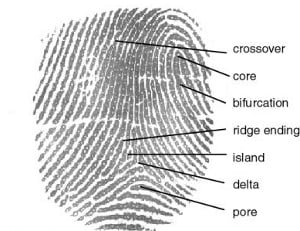Introduction:
Fingerprints are unique to individuals, with the exception of twins and other multiples, and are static through time. Because of this, they are an excellent way of identifying people. They can be lifted from a variety of surfaces and can reveal who has come into contact with certain objects.
Fingerprints are routinely used as evidence in crime investigations because they can be left on almost any surface. The Federal Bureau of Investigation maintains the Integrated Automated Fingerprint Identification System, IAFIS, which contains more than 100 million fingerprints, belonging to criminals, terrorists, and civil servants.
There are three main categories of fingerprint patterns: loops, whirls, and arches. These categories are further subdivided into commonly occurring variations. In addition to these easily visible distinguishing characters, fingerprints also have very small variations and unique patterns known as minutiae. Use the diagrams below to help you identify characteristics.
Materials:
- Black inkpad
- Stereo microscope
- Your hand, freshly washed
- White paper
Instructions:
Place your fingertip on the inkpad and roll from one side to the other. Using the same rolling motion (in the same direction), roll your finger on the paper. Roll your finger very slowly so that you do not smear the ink. If the lines of your print are clear, identify the type of print you have.


